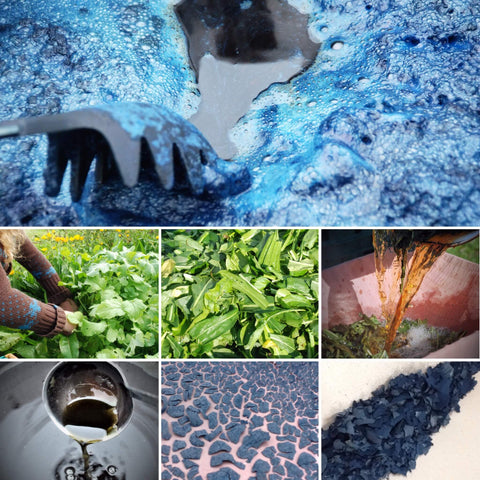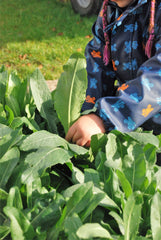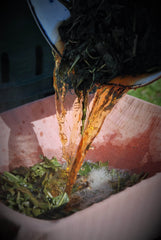Our Dyes, what they are and how they work

At Apple Oak Fibre Works quality is of the utmost importance. We proudly run a circular-economy, operating with sustainable and eco-friendly practices. We work closely with local organic farmers, collecting left over onion skins regulalry. Once we have dyed our fabrics and yarns with the organic materials we add them to our worm compost – going the extra mile by making the most of the left overs. After it is composted, we use it to fertilise our garden where we grow some of our local plant dyes like Woad, Japanese indigo, Weld and Madder. For dyes that we can’t grow locally due to climate or the sheer quantity needed, we source organically if possible.

Before you read on it might be good to explain the term ‘mordant’. The adjective ‘mordant’ was first used in the 15th century and came to modern English through Middle French, but ultimately derives from the Latin verb mordere, meaning ‘to bite’ as in wit and sarcastic humour. A mordant therefore means nothing else but a dye fixative, a substance that binds the dye on the yarn.
Up to 6kg of yarn can be dyed in 6 different shades from deep red to light pastel pinks and purples, by only using 50g of Cochineal. Turning a fairly expensive dye into a very economical one. We try to make the most of the natural dyes by exhausting the baths as much as we can. That often requires careful planning. The stunning red is only provided in the first bath, so all subsequent baths have to be spread over several different yarn bases to make sure that the dye’s potential is fully exhausted.

Colours are deepened by repeated dyeing, but also by leaving yarns overnight and sometimes even longer. We never boil our natural dyes. All of our dye extraction happens between 40 and 85 degrees (Celcius), with upfront overnight soaking.
 Once we are happy with a colour, iit gets spun to take out all the excess dye water, which gets added back into the dye pot. After heat setting, the yarn or fabric gets rinsed and spun and finally hung to dry. Once dried they get wound into Hanks, labelled and are ready to go; or in case of fabric ironed and folded.
Once we are happy with a colour, iit gets spun to take out all the excess dye water, which gets added back into the dye pot. After heat setting, the yarn or fabric gets rinsed and spun and finally hung to dry. Once dried they get wound into Hanks, labelled and are ready to go; or in case of fabric ironed and folded.
So, are natural dyes safe for the environment? The way we work, yes. We don’t use harsh mordants like tin for example. All our mordants are safe to a certain extend. Like with most things, too much of one thing isn’t good. If I would pour a glass of diluted Alum into a plant, the plant will be fine. Pour a glass full of concentrated Alum and the plant will look very ill for a while, but most likely recover. I regularly take liquid Iron as a supplement - yet it could make an infant very ill.
We use Alum as a mordant for all our protein fibres and a 2 step process of Tannins, Soda Ash and Alum for our plant based fibres. We use Iron mixed with Sodium acetate to change Iron into a more digestible plant food. We use it for saddening colours or turning yellows into greens. For Ph influencers we use Soda Ash, Cream of tartar and Citric Acid.
But what are they?
Alum - is a salt or crystal though found in nature (apparently Ireland has had a lot of Alum) it is now mainly made chemically. In chemical terms: It is a colourless astringent compound which is a hydrated double sulphate of aluminium and potassium, used in solution in dyeing and tanning. We use alum for all mordanting when necessary. We also create Alum Acetate, by combining Alum and Soda Ash for dyeing plant based fibres.
Iron - Ferrous Sulfate - is used alone as a mordant, as a colour shifter and to increase lightfastness when used in combination with other natural dyes. It is also made chemically and should be used sparingly, because it can make wool brittle. We only use a maximum of 3% in a dye bath.
Sodium Acetate - To make Iron more digestible to our filtration system, we basically 'weaken the chain' and turning Ferrous Sulfate into Ferrous Acetate. You can make your own Ferrous Acetate, by adding Iron nails to vinegar water and let the nails develop rust and create 'Iron water' after 1 week. It is much better for the environment, than Ferrous Sulfate. However, it is also difficult to measure and for our work, we need precise measurements. Combining Sodium acetate and Ferrous Sulfate to make Ferrous Acetate, makes it easy and measurable.
Citric acid - a sharp-tasting crystalline acid present in the juice of lemons and other sour fruits. It is made commercially by the fermentation of sugar and used as a flavouring and setting agent. We use it to lower Ph.
Cream of tartar - a white crystalline acidic compound obtained as a by-product of wine fermentation and used chiefly in baking powder. We use it to deepen colours.
Tara, Oak Galls, Myrobalan in short: Tannin rich plants – natural dyeing on plant fibres is not easy and most require a two step process of tannin and Alum acetate. We use Tara, Oak Gall or Myrobalan. Tara is a tannin derived from Tara pods (Caesalphinia Tinctoria) for our Cotton and Linen/flax fibres. Caesalpinia Tinctoria is a tree that grows high up in the Peruvian Mountains. You can read
Soda Ash - commercially manufactured anhydrous sodium carbonate; we use it to bring the Ph up, especially in Indigo vats and create Alum acetate when combined with Alum for dyeing plant fibres.
Hydros - sodium dithionite (also known as sodium hydrosulfite) is a white crystalline powder with a weak sulfurous odor. Although it is stable in the absence of air, it decomposes in hot water and acid solutions. We use it as a reducing agent for Indigo vats.
Fruit Sugar - used for reducing Natural Organic Indigo Vats.


